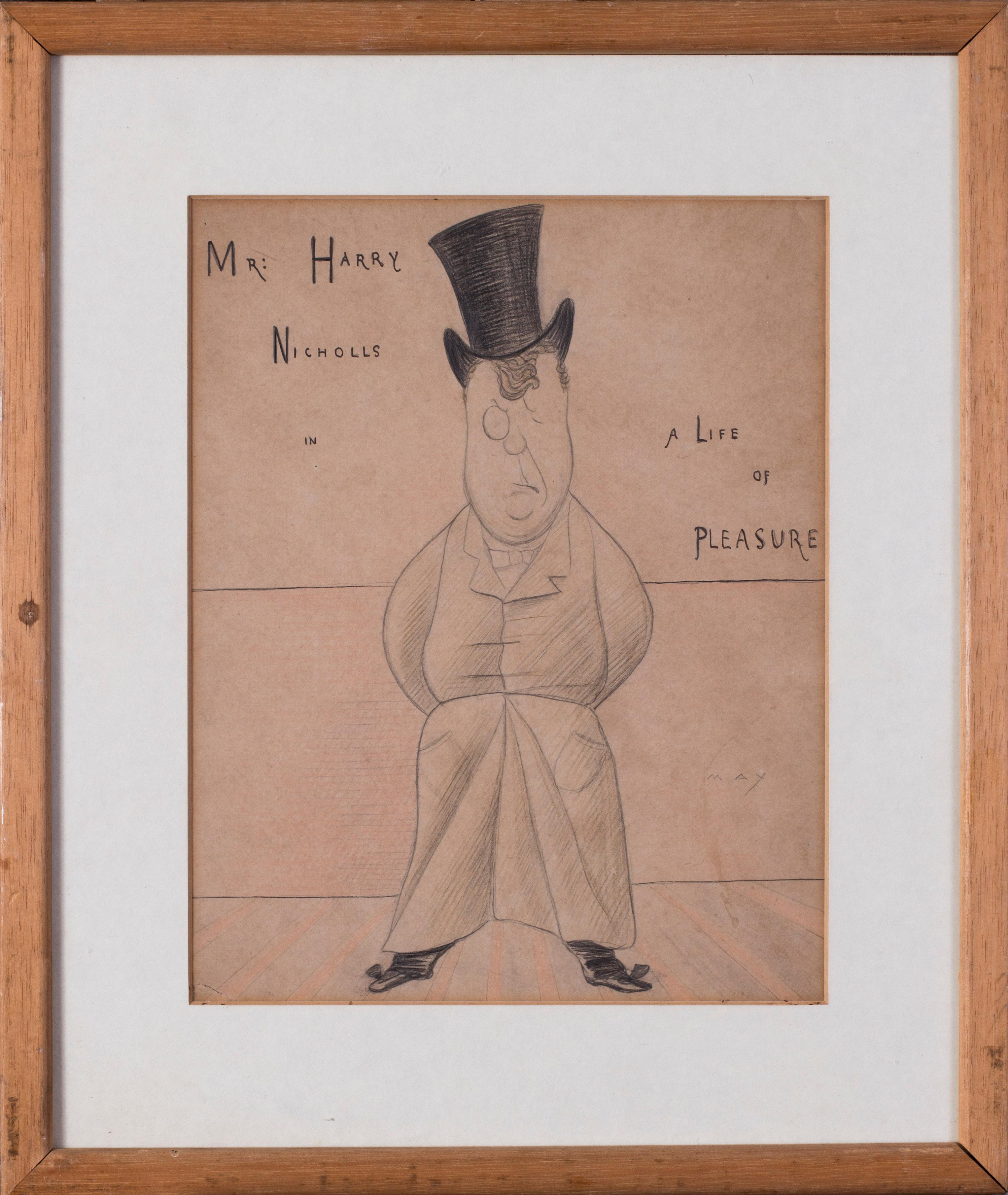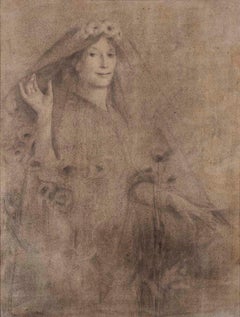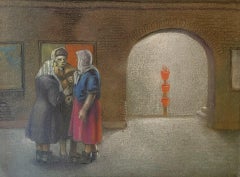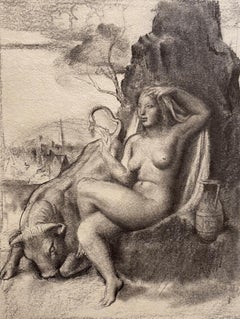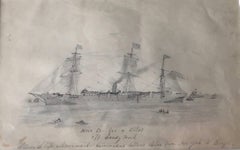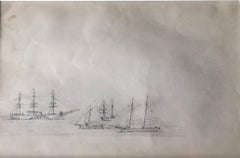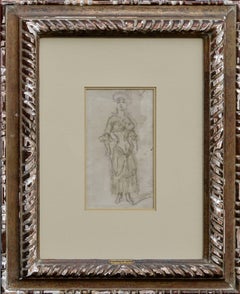Items Similar to Study for Last Sleep of Arthur in Avalon
Want more images or videos?
Request additional images or videos from the seller
1 of 3
Sir Edward Burne-JonesStudy for Last Sleep of Arthur in Avalon
About the Item
Graphite on paper
Image size: 7 1/2 x 9 inches (19 x 23 cm)
Carved gilt frame
Literature
Illustrated in Malcolm Bell's 'Sir Edward Burne-Jones, A Record and Review', London, 1899, p.127.
Provenance
Major Charles Sydney Goldman 1958
By descent to his Sons
John and Margaret Monck (John Goldman Monck) 1958-1963
Commander Victor Robert Penryn Monck (Victor Robert Penryn Monk Goldman) 1958-1963
Christie's London (Christie, Manson and Woods) 1963, John Monck and Cmdr Penryn Monck sale 26 April 1963 part lot 71
Sir John Richardson, 2019
Burne-Jones decided that the folds in the drapery in this study were too complex for the final painting and fairly soon after he simplified the draperies.
The work is a drapery study for the seated figures at the centre of Sir Edward Coley Burne-Jones monumental The Sleep of Arthur in Avalon (Museo de Arte de Ponce, Puerto Rico). The artist spent seventeen years working on the complex narrative, even moving his studio to a larger space to accommodate the canvas. Born as a commission from his patron George Howard, 9th Earl of Carlisle, to decorate a wall in his library at Naworth Castle, The Sleep of Arthur in Avalon was left unfinished in Burne-Jones’ studio upon his death. The work was bequeathed to a studio neighbour whose descendants sold it at auction in 1963, where it was purchased by Luis A. Ferré, politician and founder of the Museo de Arte de Ponce.
To his friends and family, Burne-Jones was known for his 'unpainted masterpieces'. Indeed, from his youth he made swift sketches, such as this study, that appeared effortless in contrast to his carefully crafted paintings and allowed him to work out ideas and refine details. He also drew outside of the studio, and his contemporaries remarked at his uncanny ability to do so while fully engaged in other activities. The painter W. Graham Robertson recalled; 'Once, while talking to me, he took up a little pocketbook and sketched absently as he carried on the conversation'.
The importance and role of these sketches to Burne-Jones were practical; to test out ideas and compositions directly from the mind and to use them for reference when he came to execute a final piece. Today, sketches such as this provide a useful insight to the artist's thought process as a primary source of evidence to expose gradual progression to final works.
As Burne-Jones’ work became increasing elaborate within his later compositions, so did the preparatory sketches, these exquisite and sensitive drawings were not just a compliment to the final piece, but works of art in themselves. From the 1870s onwards, Burne-Jones had an established method in the development towards a final painting. Beginning with rough exploratory sketches, he would gradually define his compositions through multiple individual sketches, isolating every detail within the scene and experimenting with various designs until he was completely satisfied with the final result.
- Creator:Sir Edward Burne-Jones (1833 - 1898, English)
- Dimensions:Height: 9 in (22.86 cm)Width: 7.5 in (19.05 cm)
- More Editions & Sizes:1 of 1Price: $9,764
- Medium:
- Movement & Style:
- Period:
- Condition:
- Gallery Location:London, GB
- Reference Number:1stDibs: LU52410529692
About the Seller
5.0
Gold Seller
Premium sellers maintaining a 4.3+ rating and 24-hour response times
Established in 2007
1stDibs seller since 2014
80 sales on 1stDibs
Typical response time: 4 hours
- ShippingRetrieving quote...Shipping from: London, United Kingdom
- Return Policy
Authenticity Guarantee
In the unlikely event there’s an issue with an item’s authenticity, contact us within 1 year for a full refund. DetailsMoney-Back Guarantee
If your item is not as described, is damaged in transit, or does not arrive, contact us within 7 days for a full refund. Details24-Hour Cancellation
You have a 24-hour grace period in which to reconsider your purchase, with no questions asked.Vetted Professional Sellers
Our world-class sellers must adhere to strict standards for service and quality, maintaining the integrity of our listings.Price-Match Guarantee
If you find that a seller listed the same item for a lower price elsewhere, we’ll match it.Trusted Global Delivery
Our best-in-class carrier network provides specialized shipping options worldwide, including custom delivery.More From This Seller
View AllDeath the Bride, Late 19th Century Pre-Raphaelite Graphite on Paper
By Thomas Cooper Gotch
Located in London, GB
Thomas Cooper Gotch RBA RI
1854 - 1931
Death the Bride
Graphite on paper
Image size: 44 x 34 inches
Pre Raphaelite Style frame
The title of the painting comes from Shakespeare. It ...
Category
Late 19th Century Pre-Raphaelite Figurative Drawings and Watercolors
Materials
Graphite
A Triptych: The Olympic Games, Modern British Drawing, Ancient Greek, Nude
By James Stroudley
Located in London, GB
Graphite on paper
Image size of rectangular works: 33 x 43 inches (84 x 109 cm)
Image size of arched central work: 38 1/4 x 29 inches (97 x 73.5 cm)
Provenance
Private Collection of Seymour Stein, Vice President of Warner Bros Records
Sotheby's 'Modern British and Irish Art,' London, 19 May 2004, lot 92
The three impressive drawings are studies for Stroudley’s ‘Olympic Games in a Demi-Lune’. From left to right the studies depict groups of athletes practicing diving, a conversing crowd of oarsmen, hurdlers mid jump and a collection of javelin throwers. This study was created in 1930 when Stroudley practiced in the British School in Rome. There are few surviving works from Stroudley’s short stay in Rome, with the compositions from his Rome period being among the last wholly successful decorative cycles produced by a Rome Scholar prior to World War II. Indeed, as can be seen here, his drawings from this period are technically brilliant and even bear comparison with those of Eric Kennington.
James Stroudley
Stroudley was born in London on 17 June 1906, the son of James Stroudley, showcard and ticket writer. He studied at Clapham School of Art (1923-27) and then at the Royal College of Art (1927-30), where his teachers included Alan Gwynne-Jones and William Rothenstein. As a recipient of the first Abbey Scholarship he was able to spend three years in Italy from 1930, where he absorbed the influences of Giotto and Piero della Francesca, and produced one of the last wholly satisfying decorative cycles by a Rome Scholar of the period. From 1934, he exhibited at the Royal Society of British Artists, and was elected to its membership in the following year.
From the Second World War – in which he worked with the Camouflage Unit – Stroudley taught at St Martin’s School of Art and was a visiting lecturer at the Royal Academy Schools. Though he continued to live in London, his later work, exhibited at the Royal Academy from 1955, indicated regular painting trips to Kent and Sussex coasts. However, much of his later work was abstract. In 1971, his former student, Peter Coker, paid homage to Stroudley by including his work in the exhibition ‘Pupil & Masters’, held at Westgate House, Long Melford, Suffolk.
Stroudley married three times, and his wives included the fashion artist to the Sun newspaper...
Category
1930s Modern Figurative Drawings and Watercolors
Materials
Paper, Graphite
The Gathering, Train Station Pastel, British Mid 20th Century
By Peter Gardner
Located in London, GB
Pastel and graphite on paper
Image size: 8 1/4 x 5 inches (21 x 12.75 cm)
Contemporary style handmade frame
The Artist
Peter Gardner was born in London in 1921. He studied at the ...
Category
Mid-20th Century Modern Figurative Drawings and Watercolors
Materials
Paper, Pastel, Graphite
Europa and the Bull, 20th Century British Graphite Drawing, Signed
Located in London, GB
Graphite on paper, signed with stamp
Image size: 9 x 6 ¾ inches
Acid free mount
Born in London, Moody studied at Battersea Polytechnic and at Royal College of Art under William Roth...
Category
20th Century English School Figurative Drawings and Watercolors
Materials
Graphite
Approaching Train, Mid-20th Century Graphite Sketch, White Gold Frame
By Gordon Scott
Located in London, GB
Pencil on Paper
Image size: 10 x 8 ¾ inches
White Gold Frame
The Artist
Gordon Scott was trained at the Royal College of Art (1934-38) under Gilbert Spencer, Alan Sorrell and Charl...
Category
Mid-20th Century Modern Figurative Drawings and Watercolors
Materials
Paper, Graphite
The Cyclist, 20th Century English Graphite Sketch
By Gordon Scott
Located in London, GB
Pencil on Paper
Image size: 18 1/2 x 14 inches (45.75 x 35.5 cm)
White gold frame
Gordon Scott
Scott was trained at the Royal College of Art (1934-38) under Gilbert Spencer, Alan So...
Category
20th Century Figurative Drawings and Watercolors
Materials
Paper, Graphite
You May Also Like
Pencil drawing off of Sandy Hook, NY of a ship on its way to Brazil
Located in Woodbury, CT
Wonderful and historically interesting scene of a steam ship off the coast of Sandy Hook, New YorkCity before its voyage to Brazil. Part of a collection of pencil drawings , all uns...
Category
1860s Victorian Figurative Drawings and Watercolors
Materials
Carbon Pencil
American ships being re-supplied possibly off the coast of Brazil or Barbados
Located in Woodbury, CT
American ships off either the coast of Brazil or Barbados from the 1860's
Category
1860s Victorian Figurative Drawings and Watercolors
Materials
Carbon Pencil
A view of Bridgetown, Barbados with the U.S.S Shamokin 1868
Located in Woodbury, CT
A very interesting scene off of the coast of Bridgetown, Barbados. The USS Shamokin at sea on one of its first voyages after being de-commisioned from the American Navy.
Category
1860s Victorian Figurative Drawings and Watercolors
Materials
Carbon Pencil
1860s Drawing L'Amazon Figurative
By Constantin Ernest Adolphe Hyacinthe Guys
Located in Soquel, CA
Antique pencil and faded watercolor wash portrait titled "L'Amazon" (French, translates "horsewoman") by Constantin Guys (French, 1802-1892), circa 1860...
Category
1860s Victorian Figurative Drawings and Watercolors
Materials
Watercolor, Rag Paper, Pencil
$700 Sale Price
20% Off
Max Beerbohm, 19th Century British caricature of Mr Harry Nichols
By Max Beerbohm
Located in Petworth, West Sussex
Max Beerbohm (British, 1872 – 1956)
Mr Harry Nicholls (In a life of pleasure), 1893
Signed ‘MAX’ (lower right), inscribed with title in ink
Pencil on paper with evidence of some wate...
Category
Late 19th Century Victorian Figurative Drawings and Watercolors
Materials
Watercolor, Paper, Pencil
By Queen Victoria's Daughter Princess Alice Framed Royal Watercolor Painting
By HRH Princess Alice Maud Mary Hanover
Located in Sutton Poyntz, Dorset
Queen Victoria’s Daughter, HRH Princess Alice Maud Mary, Of The House of Hanover.
The British Royal Family.
British ( b.1843 - d.1878 ).
Long Life And Happiness – June 11th 1860.
Wat...
Category
Mid-19th Century Victorian Figurative Drawings and Watercolors
Materials
Ink, Watercolor, Pencil
Recently Viewed
View AllMore Ways To Browse
Death Of Major
George Inness Paintings For Sale
Arthur W
John Robert Craft
John Jones Frames
Robert Wood Watercolor
Little Arthur
Robert Jones Drawing
Charles Howard Artist
Robert Goldman
Carved Wood Monk
Antique Monks Seat
1870s Painting On Wood
Antique Frames Sydney
Sir Robert Sale
Robert Wood Paintings For Sale
John Carlisle
Antique Puerto Rico




